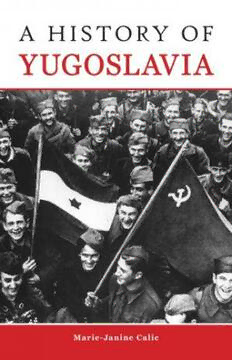
A History of Yugoslavia PDF
Preview A History of Yugoslavia
A History of Yugoslavia Central European Studies Paul Hanebrink, editor Maureen Healy, editor Howard Louthan, editor Dominique Reill, editor Daniel L. Unowsky, editor A History of Yugoslavia Marie-Janine Calic Translated by Dona Geyer Purdue University Press ♦ West Lafayette, Indiana Copyright 2019 by Purdue University. All rights reserved. Printed in the United States of America. Cataloging-in-Publication data is on file at the Library of Congress. Paperback ISBN: 978-1-55753-838-3 ePDF ISBN: 978-1-61249-563-7 ePUB ISBN: 978-1-61249-564-4 Knowledge Unlatched ISBN: 978-1-55753-849-9 Originally published in German as Geschichte Jugoslawiens im 20. Jahrhundert by Marie-Janine Calic. © Verlag C.H.Beck oHG, München 2014. Cover image: picture-alliance//HIP Media number: 14502633 Contents List of Maps vii List of Tables viii Introduction ix Abbreviations xv Chronology xvii Part I the South SlavIc MoveMent and the FoundIng oF the YugoSlav State (1878 to 1918) 1. The South Slavic Countries around 1900: The Dawn of a New Century 3 2. The National Question across the Balkans (1875 to 1903) 25 3. Radicalization (1903 to 1912) 38 4. The Three Balkan Wars (1912/1913 to 1914/1918) 51 Part II the FIrSt YugoSlavIa (1918 to 1941) 5. The Kingdom of Serbs, Croats, and Slovenes (1918 to 1929) 71 6. The 1920s: Tradition and Change 85 7. The Kingdom of Yugoslavia (1929 to 1941) 104 Part III the Second World War (1941 to 1945) 8. Occupation, Collaboration, and Resistance 125 9. The 1940s: Total War 142 Part Iv SocIalISt YugoSlavIa (1945 to 1980) 10. The Consolidation of Communist Rule (1943 to 1948) 159 11. Tito’s Socialism (1948 to 1964) 176 12. The 1960s: Transition to an Industrial Society 192 13. Reforms and Rivalries (1964 to 1968) 213 14. The New Nationalism (1967 to 1971) 223 15. After the Boom Years (1971 to 1980) 240 Part v aFter tIto (1980 to 1991) 16. The Crisis of Socialist Modernity (1980 to 1989) 251 17. The 1980s: Anomie 266 18. Disintegration and the Collapse of the State (1989 to 1991) 284 Part vI the deMISe oF YugoSlavIa (1991 to the PreSent) 19. The War of Succession (1991 to 1999) 297 20. What Remained of Yugoslavia 318 Concluding Remarks 323 Appendix A Parties, Political Organizations, and Committees 333 Appendix B Maps 335 Appendix C Tables 342 Notes 349 Bibliography 381 Index of Persons 413 List of Maps Map 1 The South Slavic Countries before 1918 336 Map 2 The Banovine in the Kingdom of Yugoslavia, 1929 337 Map 3 Yugoslavia, 1941 338 Map 4 Vision of a Greater Serbia as Presented in a Chetnik Leaflet, 1941 339 Map 5 Yugoslavia after 1945 — Ethnic Composition 340 Map 6 Successor States to Yugoslavia 341 List of Tables Table 1 Historic Regions of the Kingdom of SHS, 1918 342 Table 2 Populations of the Kingdom of SHS (according to the census of 31 January 1921) 343 Table 3 The Partition of Yugoslav Territory, 1941 343 Table 4 Ethnic Composition of Yugoslavia, 1948–1981 344 Table 5 Ethnic Homogeneity of Republics and Provinces, 1981 344 Table 6 Regional Distribution of Nations and Nationalities, 1981 345 Table 7 Percentage of Economic Sectors in the Yugoslav Gross Domestic Product, 1947–1984 345 Table 8 Level of Prosperity in Yugoslavia Compared with Other European Countries: Gross Domestic Product Per Capita (index numbers) 346 Table 9 Social Distance to Other Ethnicities (in %) 346 Table 10 Regional Disparities, 1947–1988 347 Introduction Why did Yugoslavia fall apart? Was its violent demise inevitable? Did its population simply fall victim to the lure of nationalism? How did this multina- tional state manage to survive for so long? And where do we situate the short life of Yugoslavia in the long history of the twentieth century? This book tells the story of why and under which conditions Yugoslavia was created, what held the multinational state together for more than seventy years, and why it finally broke apart in violence. It is a tale of confidence and doubt, of progress and decline, of extremes and excesses, of utopia and demise. No other European country was as colorful, multifaceted, or complex as Yugoslavia. Its turbulent history made it a byword for Balkan confusion and animosity; it stood for the backward, barbaric, and abhorrent contrast to the supposedly so civilized European continent. At the end of the nineteenth century, to cross the Danube by steamboat from the Austrian city of Semlin (Zemun) to Belgrade or travel by the Hungarian state railway over the great iron Sava Bridge to reach the train station of Bosanski Brod was to enter an exotic world that appeared both mysterious and fabulous but also at times appalling and threatening.1 Shrouded in such mystery and foreignness, “the Balkans” were consistently written out of the European context, as unfor- tunately still happens occasionally even today. However, a closer look soon dispels this shroud of mystery, because the region is tightly intertwined in the timeline of Europe’s history in both good and bad ways. Although popular images and stereotypes of a backward and violence-ridden “European other” have since been debunked as a “convenient prejudice,” the idea of the region’s structural backwardness persists, without the least empirical evidence.2 In contrast, this book addresses Yugoslav history from the perspective of the major social, economic, and intellectual changes that affected all of Europe at the turn of the twentieth century and marked its transition to modern industrialized mass society. The “great acceleration” first reached Western societies but soon expanded out toward the European periphery.3 The em- phasis here will not be primarily on structures of the longue durée and the unique developments in Balkan history, but on the overarching dynamics of
